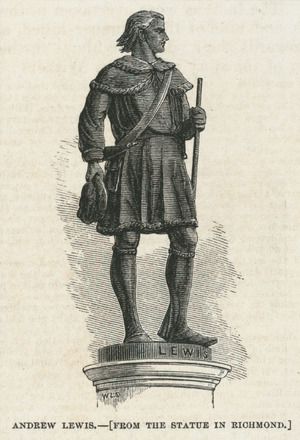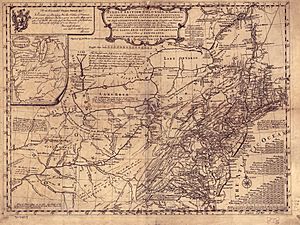Sandy Creek Expedition facts for kids
Quick facts for kids Sandy Creek Expedition |
|||||||
|---|---|---|---|---|---|---|---|
|
|||||||
| Belligerents | |||||||
Cherokee |
Shawnee | ||||||
| Commanders and leaders | |||||||
| Major Andrew Lewis Outacite Ostenaco |
|||||||
| Units involved | |||||||
| Virginia Regiment Cherokee |
|||||||
| Strength | |||||||
| 220 (8 units Virginia infantry and volunteers) 130 Cherokee warriors |
|||||||
| Casualties and losses | |||||||
| killed: 2 | 1 Shawnee prisoner | ||||||
The Sandy Creek Expedition was a military trip in 1756. Soldiers from Virginia and Cherokee warriors traveled into what is now western West Virginia. Their goal was to fight Shawnee warriors. These Shawnee warriors had been attacking farms and towns in Virginia.
The expedition started in the middle of February 1756. But bad weather and not enough food quickly slowed them down. The soldiers became discouraged. The group had to turn back in mid-March without ever finding the enemy.
This expedition was the first time the British and the Cherokees worked together in a military campaign. They fought against the French and their Native American allies. It was also Virginia's only attack during the French and Indian War.
Contents
Why the Expedition Happened
Virginia's governor started this campaign. He wanted to stop Native American raids on towns in the New River, Greenbrier River, and Tygart River valleys. About 70 settlers were hurt or captured in these attacks. Many families left their homes and moved east to the Shenandoah Valley.
In June 1755, Shawnee warriors captured Samuel Stalnaker at his home. They killed his wife and son. In July, Mary Draper Ingles and her children were captured during the Draper's Meadow Massacre. Both Mary and Samuel later escaped. They walked hundreds of miles to get back home.
Mary Ingles had lived as a captive in a Shawnee town called Lower Shawneetown. She probably told her husband, William Ingles, where it was located. William Ingles might have suggested attacking this town to Governor Dinwiddie. Samuel Stalnaker was also held there and met Mary Ingles. He escaped in May 1756.
To get back at the Shawnee, Governor Robert Dinwiddie sent soldiers called Virginia Rangers. He also sent other volunteer groups and 130 Cherokee warriors. Their mission was to attack Lower Shawneetown. This was a major Shawnee community where the Ohio River and Scioto River meet. Colonel George Washington chose Major Andrew Lewis to lead the expedition.
Virginia Rangers: Protecting Settlements
In 1755, Governor Dinwiddie created "ranging companies." These groups were meant to protect settlements from attacks by Native tribes allied with the French. They also guarded forts. Captain William Preston started one of the first Virginia Rangers companies.
The governor told Preston to keep his men moving. He wanted them to search the woods where Native Americans might attack. The Sandy Creek Expedition was the only time the Virginia Rangers went on offense during the French and Indian War.
Cherokees Join the Fight
Cherokee leaders wanted better trade with the Virginia government. They asked Governor Dinwiddie for help building a fort in South Carolina. This fort would protect Cherokee towns from attacks by French-allied Shawnee and Catawba tribes. Dinwiddie paid for the fort. In return, the Cherokees sent 130 warriors to help the Sandy Creek Expedition.
On December 14, 1755, the governor wrote to Colonel Washington. He said the Cherokees were ready to fight the French and Shawnee. He planned for them to join with Virginia Rangers. Major Lewis was chosen to lead the group.
The Cherokee warriors were led by Captain Richard Pearis and Chief Outacite Ostenaco. Dinwiddie had promised them guns and ammunition. But he could only get older, heavier rifles for them.
The Cherokees offered to teach the Virginia soldiers how to fight in the "Indian style." This meant shooting from behind cover and using stealth. Washington wanted his troops to learn these tactics. He believed Native American fighters were very skilled in the woods. He said they were "cunning and craft" and could "prowl about like Wolves."
Washington wrote that he was training his men in this new way of fighting. The Virginians also needed to learn woodcraft and how to track enemies in the wilderness. The son of a Cherokee chief told Dinwiddie that white men could not track like Native Americans.
Choosing the Path and Time
Major Lewis chose a longer, harder route to Lower Shawneetown. He avoided the easier path along the New River to the Kanawha River. He worried the Shawnee would find out about the expedition if they took the easier route.
Instead, he picked a less-used path through the mountains. They followed a trail along "Sandy Creek" (now called Dry Fork). Then they followed the Tug Fork to the Big Sandy River. This river now forms the border between West Virginia and Kentucky. The expedition went through what is now McDowell County and Mingo County.
They decided to start in February. They thought the Big Sandy River would be full of melted snow, making it easier to travel by canoe. Washington also heard that many Shawnee warriors had left Lower Shawneetown. This would make the town easier to attack.
The Expedition Begins
On February 6, 1756, Governor Dinwiddie told Lewis that Lower Shawneetown was less than 200 miles away. He urged him to start marching right away.
On February 9, the Virginia soldiers gathered near Roanoke, Virginia. They marched to meet the Cherokees at Fort Frederick. They brought over 2,000 pounds of dried beef for food. Among the troops were Lieutenant William Ingles and Captain William Preston. Both had survived the Draper's Meadow Massacre.
On February 19, the full group of 340 men and 27 pack horses set out. They crossed the Holston River and camped at Burke's Garden on February 23.
The Cherokees knew the tough mountain land and how hard wilderness fighting was. Most Virginians had never fought a winter campaign in the mountains. They had to cut trails through thick forests and cross many rivers. This was slow and tiring because of the cold weather and swollen streams.
They reached the start of the Big Sandy River on February 28. Captain Preston wrote in his journal about the "great trouble & fatigue" from heavy rain. He noted they crossed the creek 20 times that evening. On February 29, Preston wrote that the creek was often used by Native Americans. He thought that Samuel Stalnaker and other captives might have been taken that way.
For the first few weeks, the troops ate bear, deer, and buffalo. They also found potatoes from abandoned gardens. But soon, they ran out of flour and dried beef. Their food was cut in half. By March 3, the horses' corn was gone. The men hunted, but they couldn't find enough food for 340 troops. Lewis suggested eating their horses, but the men refused.
The weather was very cold, and snow made travel even slower. Lieutenant Thomas Morton wrote in his diary that the camp was full of "cursing, swearing, confusion and complaining." He said they were suffering from lack of food. Many men decided to turn back because they saw "nothing before us but inevitable destruction."
The expedition stopped on March 7 to build canoes. They hoped traveling by water would be easier. Captain Preston thought they had traveled 186 miles by March 8. On March 12, an accident caused them to lose guns and tents. A canoe overturned, and Major Lewis's canoe sank. Several valuable items were lost, including guns.
By now, food was almost gone. Men started to leave the group, trying to get home on their own. Most of them did not survive. On March 13, Lewis asked who wanted to continue. Only a few men agreed. Two companies had already decided to go back. Lewis finally had to give up and return home.
Captain Preston's diary ends with Major Lewis asking who would stay with him. Only about 20 or 30 men joined him. The other companies left. Major Lewis spoke to Chief Outacite Ostenaco. The chief was sad to see the men leave. He said he wanted to keep going, but he was unsure about his own warriors. The chief added that white men could not go without food like Native Americans.
The Difficult Journey Home
On the way home, the troops were attacked by Shawnee warriors on March 15. Two soldiers were killed. One Shawnee warrior was captured. Lieutenant Alexander McNutt suggested they continue to Lower Shawneetown to get food. But Major Lewis decided to keep going home.
The surgeon, Thomas Lloyd, later wrote that they had to kill almost all their pack horses for food. At one point, they even ate boiled leather and buffalo hide. The Tug Fork river is said to have gotten its name from this event.
Major Lewis arrived in Winchester, Virginia on April 6, 1756. He had ridden ahead on one of the last horses. The rest of the troops arrived on April 7. They later returned to Fort Frederick.
What Happened Next
Lasting Effects
Lieutenant Alexander McNutt strongly criticized Major Lewis in his journal. Lewis was very angry. When they met by chance in Staunton, Virginia in 1757, Lewis attacked McNutt.
A second Sandy Creek expedition was planned for early 1757. Captain Samuel Stalnaker was going to join. But the plan was never carried out.
Lower Shawneetown was moved upriver in late 1758. The Shawnees were afraid of the Virginians. It's not clear if they knew about the expedition or if floods made them move.
The expedition's failure made the Virginia government rethink how to defend the colony. They suggested new trade agreements with local Native American tribes to encourage peace. The House of Burgesses discussed building a line of forts along the frontier. Washington asked for money to create a professional standing army. He said forts without soldiers would not offer much protection.
William Preston continued to lead his ranger company. He had 70 men serving under him in 1757. Preston's Rangers served until May 1759.
The Sandy Creek Expedition gave valuable experience to Andrew Lewis, William Preston, and William Ingles. They would later defend Virginia in the French and Indian War and the American Revolution. The campaign also created stronger ties between the Cherokee people and the Virginia government. On June 5, 1757, Cherokee warriors helped defend Fort Cumberland. They captured a French officer who had been leading raids against English towns.
Remembering the Expedition
In 2015, a driving tour was created to follow the route of the Sandy Creek Expedition. The tour starts on the Virginia-West Virginia border. It passes through towns like Vallscreek, Canebrake, and Berwind. It ends at Wharncliffe. The tour includes ten interesting stops and campsites.
|





